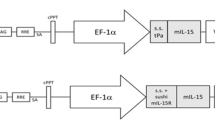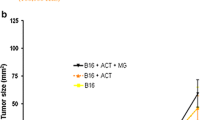Summary
The efficacy of the association of recombinant interleukin-2 (rIL-2) with chemotherapy has been investigated on an experimental model representative of clinical tumours, i.e. on post-surgical spontaneous metastases of a non-immunogenic tumour. We used the M5076 ovarian reticulum cell sarcoma, which metastatizes to the liver after intra-footpad implantation. Such a tumour appeared to be non-immunogenic by a variety of commonly used in vivo assays. Four clinically widely employed drugs, i.e. doxorubicin,cis-diamminedichloroplatinum II, cyclophosphamide and 1,3-bis-(2-chloroethyl)-1-nitrosurea (BCNU), were tested and BCNU proved to be the most effective one when administered as single injection at the maximum tolerated dose (33 mg/kg i.p.) 1 day after tumour excision. When moderate doses of rIL-2 (6 × 105 IU in three injections per day for 5 days) were administered at three different intervals after BCNU, namely before the nadir of white blood cells (1 day after BCNU), at the nadir (3 days after BCNU) or at recovery (6 days after BCNU), no increase in BCNU antitumour activity was observed. The same results were obtained by administering rIL-2 for 5 days before BCNU. Higher doses of rIL-2 (1.2 × 106 IU in three injections per day for 5 days), which were always well tolerated in sham-excised non-tumour-bearing mice, proved lethal in two out of four experiments in tumour-bearing animals. In the two experiments in which no lethality was observed, the administration of high doses of rIL-2 1 or 6 days after BCNU significantly increased the antitumour activity of BCNU alone. rIL-2 alone was not active even when administered at high doses. These results indicate that high but not moderate doses of rIL-2 may increase the activity of BCNU against a non-immunogenic tumour. Moreover, they suggest that rIL-2 tolerability is reduced in tumour-bearing mice.
Similar content being viewed by others
References
Allavena P, Grandi M, D'Incalci M, Geri O, Giuliani FC, Mantovani A (1987) Human tumor cells lines with pleiotropic drug resistance are efficiently killed by interleukin-2 activated killer cells and by activated monocytes. Int J Cancer 40: 104
Boccoli G, Masciulli E, Ruggeri EM, Carlini P, Giannella G, Montesoro E, Mastroberardino G, Isacchi G, Testa U, Calabresi F and Peschle C (1990) Adoptive immunotherapy of human cancer: the cytokine cascade and monocyte activation following high dose interleukin 2 bolus treatment. Cancer Res 50: 5795
Bonmassar E, Bonmassar A, Vladamudi S, Goldin A (1970) Immunological alteration of leukemic cells “in vivo” after treatment with an antitumor drug. Proc Natl Acad Sci USA 66: 1089
Boon T (1983) Antigenic tumor cell variants obtained with mutagens. Adv Cancer Res 39: 121
Eggermont AMM and Sugarbaker PH (1988) Efficacy of chemoimmunotherapy with cyclophosphamide, interleukin-2 and lymphokine activated killer cells in an intraperitoneal murine tumor model. Br J Cancer 58: 410
Ferrari A, Damia G, Erba E, Rossi C, Mandelli R, D'Incalci M (1989) Characterization of a novel mouse reticular cell sarcoma M5076 subline resistant to cisplatin. Int J Cancer 43: 1091
Ferro TJ, Johnson A, Everitt J, Malik AB (1989) IL-2 induces pulmonary edema and vasoconstriction independent of circulating lymphocytes. J Immunol 142: 1916
Formelli F, Rossi C, Sensi ML, Parmiani G (1988) Potentiation of adoptive immunotherapy bycis-diamminedichloroplatinum (II), but not by doxorubicin, on a disseminated mouse lymphoma and its association with reduction of tumor burden. Int J Cancer 42: 952
Gambacorti-Passerini C, Rivoltini L, Supino R, Rodolfo M, Radrizzani M, Fossati G, Parmiani G (1988) Susceptibility of chemoresistant murine and human tumor cells to lysis by interleukin 2-activated lymphocytes. Cancer Res 48: 2372
Harker WG, Tom C, McGregor JR, Slade L, Samlowski WE (1990) Human tumor cell line resistance to chemotherapeutic agents does not predict resistance to natural killer or lymphokine-activated killer cell-mediated cytolysis. Cancer Res 50: 5931
Hosokawa M, Sawamura Y, Morikage T, Okada F, Xu ZY, Morikawa K, Itoh K, Kobayashi H (1988) Improved therapeutic effects of interleukin 2 after the accumulation of lymphokine-activated killer cells in tumor tissue of mice previously treated with Cyclophosphamide. Cancer Immunol Immunother 26: 250
Kasid A, Director EP, Rosenberg SA (1989) Induction of endogenous cytokine-mRNA in circulating peripheral blood mononuclear cells by IL-2 administration to cancer patients. J Immunol 143: 736
Kedar E, Ben-Aziz R, Epstein E, Leshem B (1989) Chemoimmunotherapy of murine tumors using interleukin-2 (IL-2) and cyclophosphamide. Cancer Immunol Immunother 29: 74
Krosnick JA, McIntosh JK, Mulé JJ, Rosenberg SA (1989) Studies of the mechanisms of toxicity of the administration of recombinant tumor necrosis factor α in normal and tumor-bearing mice. Cancer Immunol Immunother 30: 133
Lee K, O'Donnell RW, Cockett ATK (1988) Ineffectiveness of adoptive chemoimmunotherapy with lymphokine-activated killer cells, interleukin-2, and Cyclophosphamide on palpable intradermal murine bladder cancer. J Biol Response Mod 7: 43
Ootsu K, Gotoh K, Houkan T (1989) Therapeutic efficacy of human recombinant interleukin-2 (TGP-3) alone or in combination with cyclophosphamide and immunocompetent cells in allogeneic, semi-syngeneic, and syngeneic murine tumors. Cancer Immunol Immunother 30: 71
Owen-Schaub LB, De Mars M, Murphy EC, JR, and Grimm EA (1991) IL-2 dose regulates TNF-α mRNA transcription and protein secretion in human peripheral blood lymphocytes. Cell Immunol 132: 193
Papa MZ, Yang JC, Vetto JT, Shiloni E, Eisenthal A, Rosenberg SA (1988) Combined effects of chemotherapy and interleukin 2 in the therapy of mice with advanced pulmonary tumors. Cancer Res 48: 122
Rosenberg SA, Mulé JJ, Spiess PJ, Reichert CM, Schwartz SL (1985) Regression of established pulmonary metastases and subcutaneous tumor mediated by the systemic administration of high dose recombinant interleukin-2. J Exp Med 161: 1169
Rosenstein M, Ettinghausen SE, Rosenberg SA (1986) Extravasation of intravascular fluid mediated by the systemic administration of recombinant interleukin 2. J Immunol 137: 1735
Sensi ML, Grazioli L, Rodolfo M, Parmiani G (1990) Mouse tumors are heterogeneous in their susceptibility to syngeneic lymphokine-activated killer cells and delineate functional subsets in such effectors. Cancer Immunol Immunother 31: 37
Author information
Authors and Affiliations
Rights and permissions
About this article
Cite this article
Acerbis, G., Cleris, L., Rodolfo, M. et al. Postsurgical adjuvant chemoimmunotherapy with recombinant interleukin-2 and 1,3-bis-(2-chloroethyl)-1-nitrosurea on spontaneous metastases of a non-immunogenic murine tumour. Cancer Immunol Immunother 34, 383–388 (1992). https://doi.org/10.1007/BF01741748
Received:
Accepted:
Issue Date:
DOI: https://doi.org/10.1007/BF01741748




